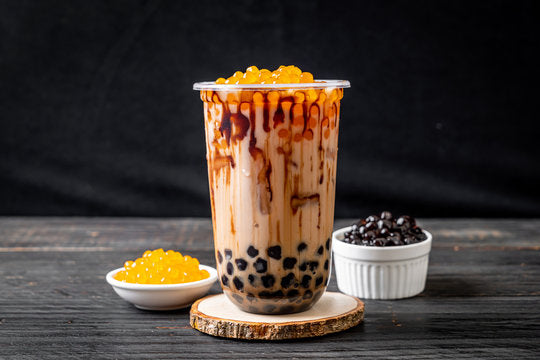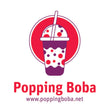HISTORY

Five years ago, the greatest soft- drink flop since New Coke appeared on store shelves across North America. Orbitz, the child of the Clearly Canadian Beverage Corporation, was a concoction of sweet liquid and colored, globular gelatin balls, packaged in a bottle shaped like a lava lamp. The marketing campaign left much to be desired. ("Set gravity aside and prepare to embark on a tour into the bowels of the Orbiterium," declared the Web site's home page.) But there was a greater obstacle to its success, because North Americans had trouble understanding why anyone would want slimy balls in a drink. The Beverage Network, a Web site aimed at the soft-drink industry, summed up the public's reaction to the "drink-with-bits" idea in its review of Orbitz's Vanilla Orange variety: "Atrocious," it wrote. " It is really impossible to enjoy a beverage that has balls floating in it. Stay away from this beverage." Orbitz was discontinued in 1998, less than a year after its launch. Most who encountered it dismissed it as the product of a marketing department not ahead of its time, but rather completely out of touch with reality. In truth, the folks at Clearly Canadian were not as hair-brained as they seemed. Over in Asia something was going on with beverages featuring gelatinous pieces over in Asia -- there, new shops and stands were spreading like wildfire, serving a drink sometimes called "boba tea" or "tapioca milk tea," but usually named "bubble tea." Of course, bubble tea shops are now ubiquitous in major North American cities. In the seven-block radius that surrounds Vancouver's Asiatown, there are no fewer than 17 bubble tea shops. And that's not counting the bubble tea outlets in the rest of the city, not to mention the many stalls found in suburban malls across Canada. These outlets, and the colorful fat strawed drinks they serve, have become part of the fabric of our cities. The positive reaction bubble tea has received in Canada, after the bust of Orbitz, is a tribute to the value of timing in the marketing.

"Perfection, a perfect party in a cup," wrote Toronto's Eye magazine in October, 2000. "What's not to like about sweet milky tea, exotic flavor shots and the cluster of little tapioca balls -- or "pearls" -- waiting like sunken treasure at the bottom of each plastic cup?" In some ways, bubble tea is the quintessential Asian fad, all bright colors and crazy shapes in hundreds of different combinations -- almost like a Pokemon you can eat. You start with black or green tea, add one of dozens of flavor powders (pineapple, pomegranate, sesame, the list is endless). You can have it with milk or without, ice it, shake it up, and serve as is, or with tapioca balls or coconut-jelly squares at the bottom. As with most made-in-Asia trends being sold to North America, the introductory pitch went something like: "It's new! It's Asian! It's cool! Have one! You'll see!" But unlike many of the Asian fads that have reached North America, this unlikely product, which hundreds of thousands of Canadians have tried by now, has some staying power. Bubble tea remains one of the more mysterious addictions we consume, its provenance mostly unknown, yet no doubt wondered about by most who buy it. Now that North America has been pursuaded to try a drink you can eat, the question is who came up with this thing in the first place? The beverage has been around for a few years, having coasted past the realm of fad into that of the longer-lasting trend, so it's a story worth looking into. And it's one that begins across the sea, in the kitchen of a sweet-toothed, "mad-scientist" tea shop owner in the Taiwanese city of Taichung. His name is Liu Han-Chieh Throughout Asia, there is a long tradition of what the Chinese call QQ drinks, "QQ" being an onomatopoeia for "chew-chew." The Vietnamese, for example, have a love of fruit-and-jelly dessert drinks. Filipino children have long enjoyed sago, a sweet drink with tapioca in the bottom. Asia is big on the party-in-your-mouth concept. Go ahead: Mix any chewy, sweet entity with any drink you can find. What's your reaction?Except tea. Don't mess with the tea. From the moment it was first popularized in China during the Tang Dynasty (AD 618-907), tea has been brewed almost exclusively in water and consumed hot and pure. The Europeans were the first to add milk and sugar, in the 17th century. The Americans were the first to ice it (surprisingly, a mid-20th century innovation). But for most of Asia, over the centuries, the only reassuring constant has been hot, plain tea. In Japan, the tea ceremony became a religious rite.

Bubble tea might have remained a quaint oddity, available only in Taichung, were it not for the arrival of a Japanese television crew. Liu cannot remember the show's name, but says it was a program aimed at young adults that scoured Southeast Asia in search of new things. It aired a segment featuring Liu's bubble tea and within days he was fielding calls from curious businessmen in Japan and Hong Kong. Then a Japanese QQ drink association (chewy drinks are popular enough to warrant their own trade association in Japan) held a meeting in Taiwan. Its members tried bubble tea, liked it, and brought the idea home.By the early '90s, bubble tea was pervasive in Japan and Hong Kong. From there, international traders pushed the product into Chinatowns across North America where it flourished, partly because it was "big overseas." By the late '90s, in the cities where it had really caught on, bubble tea moved outward to non-Asian shopping areas and night-life districts. By 2000, a veritable boom was underway with bubble operations opening down such hubs as Yonge Street in Toronto.The drink was popular partly because it was big in Asia, but also because it arrived at a peculiar moment in the history of the North American beverage industry: Throughout the second half of the 1990s, the North American palate was developing a taste for increasingly bizarre caffeinated drinks. At the start of the 1990s, Snapple gave consumers a taste for different flavors of iced tea, such as peach or raspberry, which set the stage for more complicated iced tea products, such as Arizona's Asian plum tea and Sobe's green tea with ginseng. At the same time, the frothy "mochaccino frappes" and "iced chai lattes" were being served at Starbucks and elsewhere becoming more like milkshakes or drinkable sundaes, and less like traditional coffees or teas, even Tim Hortons was introducing its own iced cappuccino, know as the IceCap, essentially a coffee slurpee. It's no coincidence that at the same time bubble tea was taking hold in North America.Of course, there was one crucial difference between these beverages and Bubble Tea. An iced chai latte might seem like a novel idea, but its texture is consistent the whole way through.

There are dozens of small oddities that make up the bubble tea experience, but surely the weirdest one of all is the alarming spectre of viscous tapioca balls or jiggly jelly squares slithering their way up the length of the wide-gauge straw toward your mouth. An anticipatory "Ew!" is written on every first-timer's face as they suck it up.But bubble tea must break the middle of the mainstream to keep growing, some in the business are worried. Will bubble tea be the next sushi, which developed a following beyond its mid-80s modishness and became a staple feature of North American life? Or will it be the next Tamagotchi, the virtual pet that was bought by the millions in 1997 and then disappeared altogether?Mr. James Park (Bubble Tea Supply), an importer of all products and equipment required in a bubble tea shop, from tapioca pearls, to straws to mixers, says bubble tea's breakthrough came thanks to youth market. Kids will try anything once, but often, also twice. "Now, some of my most successful clients are mall kiosks," Mr. Park says, indicating this is a good sign, as mall sales mean youth sales. "Now [malls] just move bubble tea."The newness of the experience has carried the product until now. "The people in the bubble tea business had to find a way to keep selling in high volumes," says Mr. Park, who admits trends such as bubble tea can experience sudden death very easily. The hope is in flavoring. In the 1990s, the early popular flavors were generally fruity. Last year, coconut was the best-seller, as was cafe mocha, which is essentially coffee-flavored tea. Now tastes such as avocado have hit the market. The thinking seems to be that, if the flavors keep expanding, the newness of the experience will never wear off.SOURCE: NP MEDIA.

